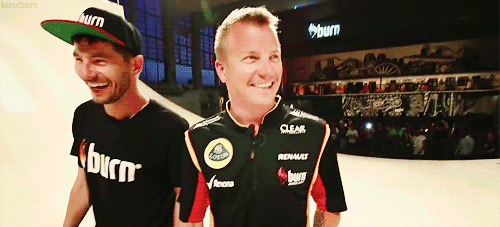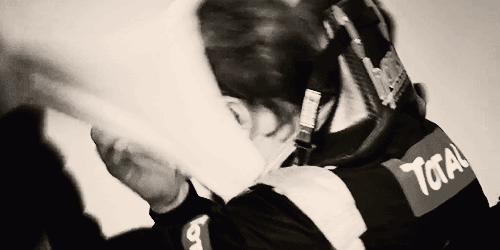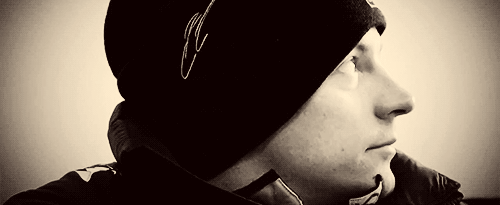Kimi Raikkonen via Sky Sports
In spite of his publicity-shy nature, Kimi Raikkonen has been in the spotlight ever since his controversial arrival on the Formula One grid back in 2001.
Peter Sauber surprised the world of F1 when he announced that he had offered the 21-year-old Finn a race deal for the following season on provision that he was handed the necessary FIA superlicence.
Having competed in just 23 car races, Raikkonen became one of the least experienced drivers ever to enter F1, but immediately delivered impressive testing performances to justify the Swiss team's faith in him.
Earlier in his career, his international results in karting were the best ever achieved by a Finnish driver, and he went on to further impress by winning the 2000 British Formula Renault Championship after taking seven wins in 10 races.
Although he met with opposition from F1 drivers wary of accepting a driver on the grid with even less experience than Jenson Button the year before him, Raikkonen proved his critics wrong.
His debut season with Sauber was sensational, the apparently ice-cool youngster proving within just a handful of races that he was a special talent.
By the time Mika Hakkinen told McLaren boss Ron Dennis that he was thinking of taking a sabbatical in 2002, the race was on to sign the younger Finn.
McLaren and Ferrari both wanted his services, but Kimi was swayed by the fact that if he drove for Ferrari he'd be number two to Michael Schumacher while at McLaren he would be allowed to win.
His 2002 season was also electric, but an underpowered McLaren on less than perfect Michelins meant he was rarely able to challenge for the lead. Although he didn't outscore team-mate David Coulthard, he regularly outqualified him. It was only due to the team's very 'un-McLaren-like' poor reliability that he didn't finish any higher than sixth place overall with 24 points.
The low point of his year came when he led the French Grand Prix with two laps left before sliding wide on oil left by Allan McNish's retiring Toyota. Marshals had failed to put warning oil flags out and the Finn was left with the sight of Michael Schumacher squeezing past him and claiming his fifth world title in the process.
Yet his first win wasn't long in coming and with McLaren beginning the 2003 season in dominant fashion, Raikkonen took the chequered flag at the Malaysian GP, the second race of the campaign.
A string of podium finishes followed, and at the halfway stage of the campaign Raikkonen was leading the drivers' standings.
However, McLaren were falling behind both Williams and Ferrari at this stage and it was only Raikkonen's tenacity and ability to steadily accumulate points which kept him in the hunt.
The Championship fight went to the wire in Japan, but a win for Rubens Barrichello guaranteed another title for Ferrari team-mate Schumacher.
Hopes were high that Kimi could go one better in 2004 but the Finn was expressing concerns about their new MP4-19 chassis before the season had even started.
He was proved correct and McLaren went on to endure a woeful season. The team eventually unveiled a replacement, yet it was too late to save their season.
Still, the MP4-19B did restore some pride within the team and also enabled Kimi to score his second grand prix victory, a stunning drive at the Belgian GP which left Schumacher trailing in his wake.
2005 was a bitter-sweet season for Kimi during which he experienced the highest highs and the lowest lows.
While the Finn had the fastest car on the grid, it was unfortunately powered by a temperamental Mercedes engine. Despite seven grand prix wins and an additional five podium finishes, he eventually had to settle for second place behind Fernando Alonso in the Drivers' Championship.
Remaining with McLaren-Mercedes in 2006, the team had one more season to hand the World title to Kimi. They couldn't. In fact, they couldn't even hand him one single race win.
Despite claiming two pole positions and three fastest race lap times, the Finn struggled to get on the podium, claiming just six top-three finishers, none of which was a P1.
Raikkonen finished the year fifth in the Drivers' Championship and, his impending arrival at Ferrari having been announced at the Italian GP moments after Michael Schumacher's retirement, he departed McLaren at the end of the season.
He started 2007 with a bang, dominating the season-opening Australian GP.
But his form spluttered soon afterwards as he battled with both reliability gremlins and the occasional driver error.
He fought back in style at the French GP where he claimed his second win of the season, which he followed up seven days later with another in Britain.
A retirement in Germany saw his Championship challenge again lose momentum, although a string of six podium finishes, including two race wins, saw Raikkonen entering the last race of the season trailing Championship leader Lewis Hamilton by seven points.
And to the surprise of many, the Ferrari driver pulled it off - Raikkonen taking victory in the Brazilian GP with Hamilton able to finish only seventh.
However, Raikkonen's title defence proved less than impressive, a lack of pace - particularly in qualifying - begetting at times a lack of motivation.
Two wins the opening four races saw Raikkonen firmly in the hunt for the crown, however, his victory in Spain at the end of April would be his final win of the season.
Bad luck also played a part - Hamilton hit Raikkonen from behind in the pit lane at the Canadian GP, a broken exhaust cost him victory in France and the wrong call on tyres put paid to his hopes at Silverstone.
His performances improved after he reverted to an older version of Ferrari's F2008 late in the season but the general impression was that Raikkonen's driving lacked the spark of 2007.
Raikkonen eventually finished a disappointing campaign down in third place, Ferrari nevertheless extending his contract to the end of 2010.
[via Sky Sports]
Peter Sauber surprised the world of F1 when he announced that he had offered the 21-year-old Finn a race deal for the following season on provision that he was handed the necessary FIA superlicence.
Having competed in just 23 car races, Raikkonen became one of the least experienced drivers ever to enter F1, but immediately delivered impressive testing performances to justify the Swiss team's faith in him.
Earlier in his career, his international results in karting were the best ever achieved by a Finnish driver, and he went on to further impress by winning the 2000 British Formula Renault Championship after taking seven wins in 10 races.
Although he met with opposition from F1 drivers wary of accepting a driver on the grid with even less experience than Jenson Button the year before him, Raikkonen proved his critics wrong.
His debut season with Sauber was sensational, the apparently ice-cool youngster proving within just a handful of races that he was a special talent.
By the time Mika Hakkinen told McLaren boss Ron Dennis that he was thinking of taking a sabbatical in 2002, the race was on to sign the younger Finn.
McLaren and Ferrari both wanted his services, but Kimi was swayed by the fact that if he drove for Ferrari he'd be number two to Michael Schumacher while at McLaren he would be allowed to win.
His 2002 season was also electric, but an underpowered McLaren on less than perfect Michelins meant he was rarely able to challenge for the lead. Although he didn't outscore team-mate David Coulthard, he regularly outqualified him. It was only due to the team's very 'un-McLaren-like' poor reliability that he didn't finish any higher than sixth place overall with 24 points.
The low point of his year came when he led the French Grand Prix with two laps left before sliding wide on oil left by Allan McNish's retiring Toyota. Marshals had failed to put warning oil flags out and the Finn was left with the sight of Michael Schumacher squeezing past him and claiming his fifth world title in the process.
Yet his first win wasn't long in coming and with McLaren beginning the 2003 season in dominant fashion, Raikkonen took the chequered flag at the Malaysian GP, the second race of the campaign.
A string of podium finishes followed, and at the halfway stage of the campaign Raikkonen was leading the drivers' standings.
However, McLaren were falling behind both Williams and Ferrari at this stage and it was only Raikkonen's tenacity and ability to steadily accumulate points which kept him in the hunt.
The Championship fight went to the wire in Japan, but a win for Rubens Barrichello guaranteed another title for Ferrari team-mate Schumacher.
Hopes were high that Kimi could go one better in 2004 but the Finn was expressing concerns about their new MP4-19 chassis before the season had even started.
He was proved correct and McLaren went on to endure a woeful season. The team eventually unveiled a replacement, yet it was too late to save their season.
Still, the MP4-19B did restore some pride within the team and also enabled Kimi to score his second grand prix victory, a stunning drive at the Belgian GP which left Schumacher trailing in his wake.
2005 was a bitter-sweet season for Kimi during which he experienced the highest highs and the lowest lows.
While the Finn had the fastest car on the grid, it was unfortunately powered by a temperamental Mercedes engine. Despite seven grand prix wins and an additional five podium finishes, he eventually had to settle for second place behind Fernando Alonso in the Drivers' Championship.
Remaining with McLaren-Mercedes in 2006, the team had one more season to hand the World title to Kimi. They couldn't. In fact, they couldn't even hand him one single race win.
Despite claiming two pole positions and three fastest race lap times, the Finn struggled to get on the podium, claiming just six top-three finishers, none of which was a P1.
Raikkonen finished the year fifth in the Drivers' Championship and, his impending arrival at Ferrari having been announced at the Italian GP moments after Michael Schumacher's retirement, he departed McLaren at the end of the season.
He started 2007 with a bang, dominating the season-opening Australian GP.
But his form spluttered soon afterwards as he battled with both reliability gremlins and the occasional driver error.
He fought back in style at the French GP where he claimed his second win of the season, which he followed up seven days later with another in Britain.
A retirement in Germany saw his Championship challenge again lose momentum, although a string of six podium finishes, including two race wins, saw Raikkonen entering the last race of the season trailing Championship leader Lewis Hamilton by seven points.
And to the surprise of many, the Ferrari driver pulled it off - Raikkonen taking victory in the Brazilian GP with Hamilton able to finish only seventh.
However, Raikkonen's title defence proved less than impressive, a lack of pace - particularly in qualifying - begetting at times a lack of motivation.
Two wins the opening four races saw Raikkonen firmly in the hunt for the crown, however, his victory in Spain at the end of April would be his final win of the season.
Bad luck also played a part - Hamilton hit Raikkonen from behind in the pit lane at the Canadian GP, a broken exhaust cost him victory in France and the wrong call on tyres put paid to his hopes at Silverstone.
His performances improved after he reverted to an older version of Ferrari's F2008 late in the season but the general impression was that Raikkonen's driving lacked the spark of 2007.
Raikkonen eventually finished a disappointing campaign down in third place, Ferrari nevertheless extending his contract to the end of 2010.
[via Sky Sports]








0 comments